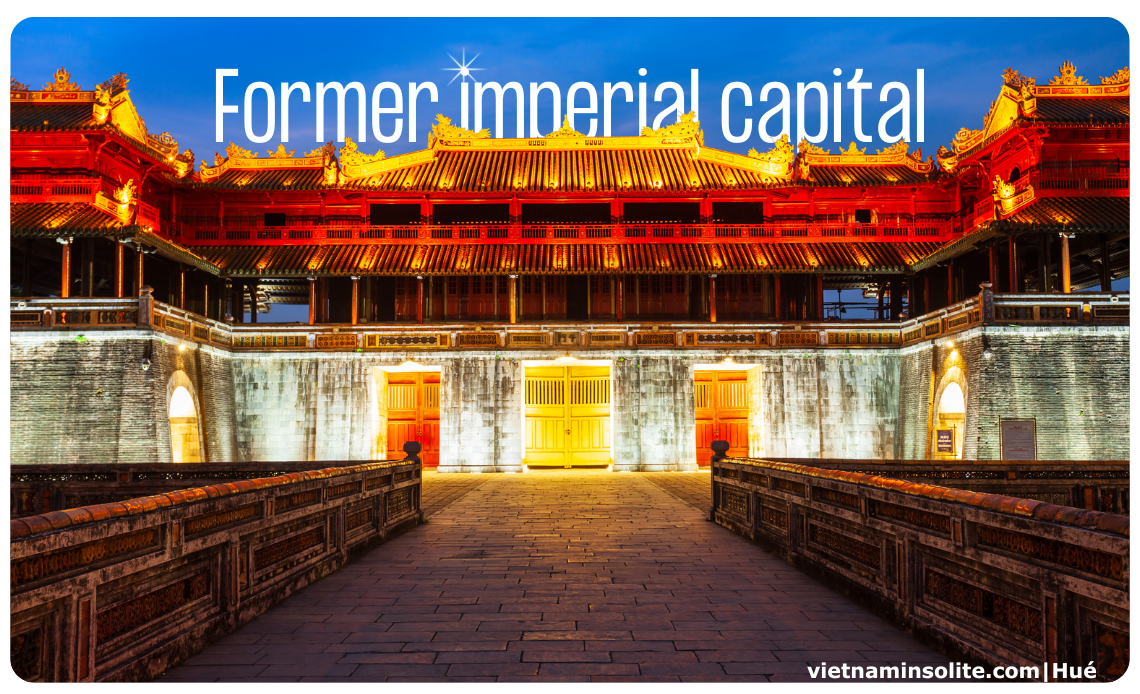
The Imperial Cuisine Of Hue: A Popular Cuisine With Royal Flair - Vietnam
The former imperial city of Hue is home to as many historical riches as culinary ones. Indeed, the capital of the Nguyen dynasty (1802-1945) holds the secrets of Vietnamese haute cuisine, renowned for its refinement both in taste and presentation.
In this article, we invite you to discover the culinary identity of this city through its main dishes.
Introduction to Vietnamese Imperial Cuisine
Hue, Historical and Culinary Birthplace
The cuisine of Central Vietnam, particularly that of Hue, stands out for the size of its dishes and their very refined presentations. It is a popular culinary culture inspired by the tastes of thirteen Nguyen emperors over nearly 150 years when Hue was the imperial capital.

Imperial Cuisine for the Nguyen Dynasty
A healthy body, in a healthy mind! If we were to mention it in Le vietnam toute une histoire d’équilibre, Vietnamese cuisine is catalyzed by the philosophy of Yin and Yang. Everything is carefully thought out to ensure a balance between sweet and salty, hot and cold, bitterness and sweetness... Thus, when it came to feeding the emperor, everything was calculated down to the smallest detail. The imperial cuisine of the Nguyen dynasty had to meet the natural needs of the royal body, ensuring health and strength. Yin and Yang were present in every dish, and each bite was a concentration of medicinal virtues. Food held such importance that the emperors were attended to by two departments made up of nearly 400 people, a cohort partly justified by the number of concubines to be fed. An emperor's table would feature no fewer than 50 dishes prepared by 50 chefs, with the preparation overseen by doctors. It is thanks to these imperial attentions that we owe the quintessence of Vietnamese cuisine – recognized worldwide for its refinement and artistic qualities. Indeed, each dish is presented as a work of art: sculptures of vegetables, fruits, and a play of colors. Vietnamese imperial cuisine is first tasted with the eyes!
Popular Dishes with Imperial Traits
Before you step into the seats of a royal banquet, all you need to do is cross the street in Hue to taste the life of a king. Yes, even the street food here is based on ancient culinary sciences. Moreover, dishes originating from Hue represent more than half of the 3,000 Vietnamese dishes listed to date. In short, Hue invites you to taste a 4-star street food, once known as royal dishes (prepared outside the citadel).
Already mentioned in the 10 specialties not to miss in Central Vietnam, the Banh (pastries, cakes) are undoubtedly the perfect expression of imperial heritage. These small bites are a concentration of flavors and balance, presented in their most beautiful forms.
The Banh Bot Loc or its counterpart, the Ban Loc Tran
This dish attracts the curious with its elastic texture and orange hues. This dumpling, made from tapioca flour, is filled with shrimp and pork belly. The Banh Bot Loc is wrapped in a banana leaf, while the Banh Loc Tran is not.

The Refined Banh Beo
Served in a small bowl, Banh Beo is a layer of steamed white rice, topped with onions, shrimp, or pork. This dish is found both on the tables of fine restaurants and at small street stalls, always accompanied by the essential nuoc-mam sauce.
The Surprising Banh Ram It
This small ball of joy consists of two elements - the ít and the Ram. The ít is a sticky rice ball stuffed with pork and/or shrimp, while the Ram is a crispy chip made from rice flour and coconut milk. They are then combined: the ít sits on its crispy bed before being served and eaten... quickly, very quickly, too quickly.
Dining at an Imperial Table in Hue
Today, an imperial table typically consists of about a dozen dishes. These dishes stand out in three ways: a selection of simple ingredients elevated by sophisticated cooking techniques and brought to life with refined presentation. Here are some dishes you will surely find on your table: fragrant chicken soup, the famous Banh, spring rolls, fish grilled in a banana leaf (a delight), spicy beef cooked in wild cow leaves... and the delicious yellow pancakes (Banh Xeo)...
Where to enjoy imperial cuisine in Hue?
The Peaceful Y Thao Garden Restaurant
Away from the urban bustle, this former villa invites you to enjoy a discovery menu in bucolic green spaces. You will find several discovery menus consisting of 5 to 6 dishes, ranging from 300,000 VND (12$) to 600,000 VND (20$). Try to arrive early as this spot is very popular with both locals and tourists.
- Page facebook : https://www.facebook.com/YThaoGroup/
- Average price per person: 15$
- Address : 03 Đường Thạch Hãn, Thuận Hoà, Thành phố Huế, Thừa Thiên Huế, Viêt Nam
Ancient Hue Garden Houses
The Ancient Hue Garden Houses stands out for its bucolic setting and traditional architectural features. Its beautiful garden buildings invite you to embrace the lifestyle of the mandarins of old, specific to the former imperial city of Hue. At the Kim Long Fine Restaurant table, you will enjoy royal dishes that are as beautiful as they are delicious !
- Site Internet : https://ancienthue.com.vn
- Average price per person : 30$
- Address : 104/47 Kim Long, Thành phố Huế, Thừa Thiên Huế, Vietnam.
The Tinh Gia Vien Restaurant
It’s hard not to mention Mme Ton Nu Ha in this article – the owner of the establishment, a descendant of the royal lineage, and a prominent figure in Vietnamese cuisine. She has dedicated her life to promoting and preserving imperial culinary traditions, first on a national level and then internationally.
While this restaurant is now promoted by all tourism actors, we must admit that sometimes the presentation of the dishes (which is an art form) takes precedence over their flavors.
- Site Internet : https://www.tinhgiavien.com.vn
- Average price per person : 50$
- Address : 7 kiet 28 Lê Thánh Tôn, Phú Hậu, Thành phố Huế, Thừa Thiên Huế, Viêt Nam
- Bonus: Offers cooking classes
If you don’t make it to Central Vietnam
Quan An Ngon in Hanoi
A must-visit if you’re only visiting the north of Vietnam. A true institution in Hanoi, Quan An Ngon is a favorite spot among locals. In this former colonial building, you’ll have the opportunity to taste all the specialties of Vietnam, including those from Hue. You’ll find the famous Banh (on the front page if the menu hasn’t changed), the famous Banh Xeo pancake (the Saigonese version, so it’s huge), and the delicious lemongrass chicken skewers… In short, while it may not be a royal feast in the strictest sense, it’s still a feast! Whether with family or friends, order several dishes, nibble, and enjoy!
- Site Internet (facebook) : Quán Ăn Ngon
- Average price per person : 15$
- Address : 18 Phan Bội Châu, Cửa Nam, Hoàn Kiếm, Hà Nội 111103, Viêt Nam
- Bonus: Arrive early as the restaurant gets very crowded!
- Note, there are several Quan An Ngon locations, but the one near the train station is the best!
The Nét Hué Chain in Hanoi
When we miss the flavors of Central Vietnam, we head to Nét Hué to enjoy Banh Ram It. This restaurant chain offers a culinary tour of the center, with unique dishes or shared plates to enjoy with your travel companions, all at affordable prices!
- Site Internet : https://www.nethue.com.vn
- Average price per person : 10 $ (pour les gros appétits)
- Address : 43 Mai Hắc Đế, Bùi Thị Xuân, Hai Bà Trưng, Hà Nội, Viêt Nam
- There are several locations, and the one listed is the one located next to the agency.
Small Dishes, Short Descriptions, Big Meal
In Vietnam, it is rare to have lunch or dinner centered around a single dish. Don’t worry, we’re not talking about a table with fifty dishes. However, these small bites of pleasure fit perfectly into the Vietnamese culinary tradition, which aims to create a delightful experience shared with family or friends. In this context, we recommend indulging in a few imperial treats by ordering a little of everything... within reason, of course!
If you have any questions or would like us to organize your trip, please contact Vietnam Insolite !
Leave a comment and let’s chat :)






